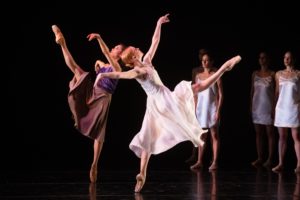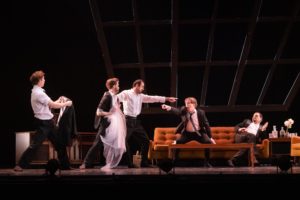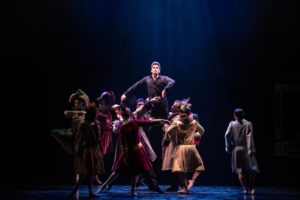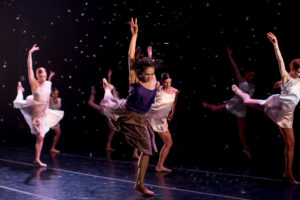Milwaukee Ballet: Teague-Howell, Glassman and O’Donnell / Mixed Bill - Vancouver Ballet Society
- Home
- Reviews 2020 - 2023
- Milwaukee Ballet: Teague-Howell, Glassman and O’Donnell / Mixed Bill

Much like the 19th-century Impressionist movement that forever changed the art world through the genius of Claude Monet, Auguste Renoir, Edgar Degas and others, Sergei Diaghilev’s Ballets Russes of the early 20th century forever changed the dance world, through such artists as Vaslav Nijinsky, Michel Fokine and George Balanchine. As part of Milwaukee Ballet’s 50th-anniversary season, its latest program, Ballet Russe Reimagined, celebrated the legacy of the Ballets Russes with a trio of works based on ballets made popular by the legendary company.
The opening-night performance, February 13, at Milwaukee’s Pabst Theater, began with Nicole Teague-Howell’s The Firebird: Rise, a reimagining of Fokine’s 1910 ballet The Firebird, set to Igor Stravinsky’s original score. A modern-day fairytale inspired by Alexandre Benois and Fokine’s original scenario for The Firebird, taken from Russian fairytales, the Ballets Russes’ production told of Koschei the Immortal who held 13 princesses prisoner, and the efforts of the Firebird and Prince Ivan to free them.

In Teague-Howell’s timely #MeToo–aligned version, dancer Josiah Cook portrayed a psychologically and physically abusive man (à la Koschei the Immortal), whose ire and desire was directed toward a woman (Lahna Vanderbush), who, trapped by him, is in fear and despair, ultimately freeing herself and moving on with life.
Teague-Howell, a leading artist with Milwaukee Ballet (the company’s dancers are divided into two groups, leading artists and artists), opened her ballet with the Firebird (Lizzie Tripp) witnessing the cruel nature of Cook’s character. Wary yet confident, Tripp moved through outstretched dance steps that highlighted her long limbs and graceful extension. The scene, to Stravinsky’s ominous music, featured a struggle of wills between Cook’s and Vanderbush’s characters, played out in a gripping contemporary ballet pas de deux featuring sleek twisting and turning, combative choreography.
The “Prince Ivan” of Teague-Howell’s ballet, danced by leading artist Randy Crespo, was smitten by Vanderbush’s character. His caring demeanour in a playful dance offered her a brief glimmer of hope for a better life, ultimately resulting in a violent duet between Cook and Vanderbush, which ends with a chorus of seven women led by the Firebird. Teague-Howell’s ballet was solid in its imagery and storytelling with searing performances by Cook and Vanderbush.

The surprise gem of the program came next in company artist Garrett Glassman’s I Do, Don’t I?, loosely inspired by Bronislava Nijinska’s wedding-themed Les Noces (1923). Glassman, who choreographed the Orwellian work Affixed for the company in 2018, chose to do a comedy with the setting of a bachelor party instead of a reinterpretation of Nijinska’s proto-feminist ballet about a woman’s duty to marry.
Set to Stravinsky’s music for Léonide Massine’s ballet Pulcinella, leading artist Davit Hovhannisyan portrayed a groom having reservations about marrying his betrothed (Teague-Howell). The cleverly choreographed ballet assuages Hovhannisyan’s worries over its course with laugh-out-loud brilliance usually reserved for hit Broadway comedies. The impeccably rehearsed cast of five men performed some very funny and adroitly danced gags, involving a ring box, a bride’s veil, suit coats, neckties and a couch. Led by best man Patrick Howell, who left the audience howling with laughter at his perfectly timed antics and priceless facial expressions, the entire cast delighted in a bevy of ring hiding, boozing and merciless teasing of the groom. The ballet was a comedic triumph.
Concluding the program, Sacre, by resident choreographer Timothy O’Donnell, took on Nijinsky’s The Rite of Spring. Having had countless reinterpretations since its riotous premiere in Paris in 1913 — most derivations of its original story of a pagan tribe’s ritualistic human sacrifice — O’Donnell’s contemporary ballet, also set to Stravinsky’s landmark Rite of Spring score, took a different approach, focusing on the real events of Nijinsky’s tumultuous life.

Australian O’Donnell, who won Milwaukee Ballet’s international choreographic competition with Genesis in 2009, has premiered five ballets with the company since joining them as a dancer in 2012 (he is still performing with them, as a leading artist). Sacre, O’Donnell first large narrative ballet for Milwaukee Ballet, showcased the complicated romantic and working relationship between Nijinsky (Barry Molina) and Diaghilev (Ransom Wilkes-Davis), Nijinsky’s confrontations within the Ballets Russes as both star dancer and choreographer, and his eventual mental breakdown.
While O’Donnell’s approach was unique and the dancers performed his detailed choreography marvellously, the ballet at times felt repetitive in theme. Add to that, Nijinsky, the biggest star of his generation, known for being naïve, shy and recessive offstage, was portrayed in Sacre as needy, somewhat arrogant and interminably jealous. This may have been O’Donnell’s intent, in order to highlight what he perceived as Nijinsky’s emotional and mental state during that period, but the approach came off as melodramatic. Overall though, Sacre proved an intriguing interpretation of The Rite of Spring, ending what was a rather memorable evening of dance.
— STEVE SUCATO

Tags: Ballets Russes Bronislava Nijinska Garrett Glassman George Balanchine Igor Stravinsky international dance news Léonide Massine Lizzie Tripp Michel Fokine Milwaukee Ballet Nicole Teague-Howell Pulcinella Sergei Diaghilev The Firebird The Rite of Spring Timothy O'Donnell Vaslav Nijinsky
